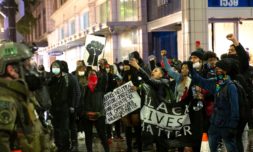Museums set out to preserve artefacts that represent 2020’s BLM protests, recording history in real time.
The tragic killing of George Floyd has brought about an incredibly transformative period in American history that is guaranteed to be studied by historians for years to come. As the ongoing civil rights uprisings encourage nationwide institutions to respond with urgency, dozens of museums – which typically have little involvement in ‘current’ events (obviously) – are now racing to contextualise and chronicle history, right at the moment it’s being made.
Aaron Bryant is at the forefront of this unique preservation process. A curator of visual culture, photography, and contemporary history at the Smithsonian’s National Museum of African American History and Culture (NMAAHC), he is leading what’s being referred to as a ‘rapid-response collecting initiative.’ Bryant’s goal is to secure the stories, images, and objects that will provide the public (as well as historians) with an opportunity to one day understand the tumultuous time we’re experiencing at present.

Items of interest include placards, tear gas canisters, mobile phone footage, and original art, with possibilities for their use ranging from online exhibitions to round-table discussions.
‘History isn’t just about keeping records of random events,’ he says. ‘It’s really about documenting and evaluating the evolution of human progress and our humanity. This moment would be a part of that story.’
Asking protestors to keep physical objects such as signs, as well as digitally upload protest-related audio recordings, videos, and pictures, Bryant has begun making t-shirts and artwork. He aims to donate the proceeds to various movements and charities supporting the cause.
The Smithsonian is on site at Black Lives Matter Plaza collecting signs that have been removed from the White House fence for preserve them. I’ve also been told UMD library took some too. @ABC7News pic.twitter.com/WGyCEpkwsj
— Caroline Patrickis (@Cpatrickis) June 10, 2020





















